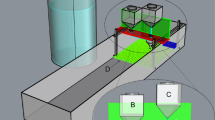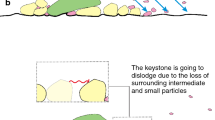Abstract
Estuarine turbidity maxima (ETM) can retain suspended particulate matter (SPM) through advection, settling, aggregation, and nonlinearities in bed processes. We define a parameter space descriptive of ETM water column particle trapping processes through a scaling analysis of the local and integral SPM balances. There are six primary non-dimensional parameters for the large particles or aggregates that are typically trapped in an ETM. Rouse numberP, the ratio of settling velocityW S to the shear velocityU *, describes the material trapped in the ETM in terms of the local vertical balance between vertical mixing and aggregate settling. Advection numberA = PDU/UT scales the landward transport of SPM in terms of flood-ebb velocity difference (ΔU; the internal asymmetry) and maximum tidal current (U T ). Supply number Sr =PU r /U t defines SPM supply and removal (U r is river flow). Changes in the estuarine inventory of SPM are described in terms of a Trapping EfficiencyE, a ratio of peak ETM concentration to fluvial or marine supply concentration. The effects of aggregation and disaggregation in the integral dynamic balance are quantified by a Floc number Θ = Φ/Г that describes the balance of aggregation (Φ) and disaggregation (Г). The balance between erosion and deposition at the bed is described by the Erosion number Π = Ψ/Ω, the ratio of erosion (Ψ) to deposition(Ω). The non-dimensional, integral SPM conservation equation is then used to examine steady and unsteady particle trapping scenarios, including adjustments to a change in river flow and to a neap-spring transition in salinity intrusion and stratification.
Similar content being viewed by others
Literature Cited
Brennan, M. L., D. H. Schoellhamer, J. R. Burau, andS. G. Monismith. 2002. Tidal asymmetry and variability of bed shear stress and sediment bed flux at a site in San Francisco Bay, CA, p. 93–107.In J. C. Winterwerp and C. Kranenburg (eds.), Fine Sediment Dynamics in the Marine Environment. Elsevier, Amsterdam, The Netherlands.
Burchard, H. andH. Baumert. 1998. The formation of estuarine turbidity maxima due to density effects in the salt wedge: A hydrodynamic process study.Journal of Physical Oceanography 28: 309–321.
Chisholm, T. A. 1999. A two-component aggregation model. Ph.D. Dissertation, College of William and Mary, Williamsburg, Virginia.
Crump, B. C., J. A. Baross, andC. A. Simenstad. 1998. Dominance of particle-attached bacteria in the Columbia River estuary.Aquatic Microbiology and Ecology 14:7–18.
Cudaback, C. N. andD. A. Jay. 2000. Tidal asymmetry in an estuarine pycnocline: 1, Depth and thickness.Journal of Geophysical Research 105:26,237–26,252.
Dyer, K. andE. M. Evans. 1989. Dynamics of turbidity maximum in a homogeneous tidal channel.Journal of Coastal Research 5: 23–30.
Fain, A. M. V., D. A. Jay, D. J. Wilson, P. M. Orton, andA. M. Baptista. 2001. Seasonal, monthly and tidal patterns of particulate matter dynamics in a stratified estuary.Estuaries 24:770–786.
Festa, J. F. andD. V. Hansen. 1978. Turbidity maxima in partially mixed estuaries—a two-dimensional numerical model.Estuarine Coastal and Shelf Science 7:347–359.
Friedrichs, C. T., B. A. Armbrust, andH. E.de Swart. 1998. Hydrodynamics and equilibrium sediment dynamics of shallow, funnel-shaped tidal estuaries, p. 315–328.In J. Dronkers and M. Scheffers (eds.), Physics of Estuaries and Coastal Seas. Balkema Press, Rotterdam, The Netherlands.
Geyer, W. R. 1993. The importance of suppression of turbulence by stratification on the estuary turbidity maximum.Estuaries 16: 113–115.
Geyer, W. R., J. D. Woodruff, andP. Traykovski. 2001. Sediment transport and trapping in the Hudson River estuary.Estuaries 24:670–679.
Han, M. andD. F. Lawler. 1992. Relative insignificance of G in flocculation.Journal of the American Water Works Association 84: 79–91.
Hansen, D. V. andM. Rattray, Jr. 1965. Gravitational circulation in straits and estuaries.Journal of Marine Research 23:104–122.
Jay, D. A. andJ. D. Musiak. 1994. Particle trapping in estuarine turbidity maxima.Journal of Geophysical Research 99:20,446–20,461.
Jay, D. A. andJ. D. Musiak. 1996. Internal tidal asymmetry in channel flows: Origins and consequences, p. 219–258.In C. Pattiaratchi (ed.), Mixing Processes in Estuaries and Coastal Seas, American Geophysical Union, Coastal and Estuarine Sciences Monograph, Washington, D.C.
Jay, D. A. andJ. D. Smith. 1990a. Residual circulation in shallow, stratified estuaries. I. Highly-stratified systems.Journal of Geophysical Research 95:711–732.
Jay, D. A. andJ. D. Smith. 1990b. Circulation, density distribution and neap-spring transitions in the Columbia River Estuary.Progress in Oceanography 25:81–112.
Jay, D. A., R. J. Uncles, J. Largier, W. R. Geyer, J. Vallino, andW. R Boynton. 1997. A review of recent developments in estuarine scalar flux estimation.Estuaries 20:262–280.
Knowles, S. C. andJ. T. Wells. 1998. In situ aggregate analysis camera (ISAAC): A quantitative tool for analyzing fine-grained suspended material.Limnology and Oceanography 43:1954–1962.
Lerczak, J. A. andW. R Geyer. 2006. Mechanisms driving the time-dependent salt flux in a partially mixed estuary.Journal of Physical Oceanography 36:2296–2311.
McCool, W. W. andJ. D. Parsons. 2004. Sedimentation from buoyant fine-grained suspensions.Continental Shelf Research 24: 1129–1142.
Orton, P. M., D. Wilson, D. A. Jay, and A. M. V. Fain. 2002. High resolution sediment dynamics in salt-wedge estuaries, p. 61–67.In G. Gelfenbaum and G. Kaminsky (eds.), Southwest Washington Coastal Erosion Workshop Report 2000, U.S. Geological Survey Open File Report 02-229. Menlo Park, California.
Ruiz, J. andA. Izquierdo. 1997. A simple model for the break-up of marine aggregates by turbulent shear.Oceanologica Acta 20: 597–605.
Sanford, L. P., S. E. Suttles, andJ. P. Halka. 2001. Reconsidering the physics of the Chesapeake Bay estuarine turbidity maximum.Estuaries 24:655–669.
Scully, M. E. andC. T. Friedrichs. 2003. Influences of asymmetries in overlying stratification on near-bed turbulence and sediment suspension in a partially mixed estuary.Ocean Dynamics 53:208–219.
Scully, M. E. and C. T. Friedrichs. 2007. Sediment pumping by tidal asymmetry in a partially mixed estuary.Journal of Geophysical Research 112, CO 7028, doi 10.1029/2006JC003784.
Simenstad, C. A., D. Reed, D. A. Jay, F. Prahl, L. Small, andJ. A. Baross. 1995. LMER in the Columbia River Estuary: An interdisciplinary approach to investigating couplings between hydrological, geochemical and ecological processes, p. 437–444.In K. R. Dyer and R. J. Orth (eds.), Changing Particle Fluxes in Estuaries: Implications from Science to Management. Olsen and Olsen Press, Friedensborg, Denmark.
Sternberg, R. W., I. Berhane, andA. S. Ogston. 1999. Measurement of size and settling velocity of suspended aggregates on the northern California continental shelf.Marine Geology 154:43–53.
Winterwerp, J. C. 2002. Scaling parameters for high-concentrated mud suspensions in tidal flow, p. 171–186.In J. C. Winterwerp and C. Kranenburg (eds.), Fine Sediment Dynamics in the Marine Environment. Elsevier, Amsterdam, The Netherlands.
Winterwerp, J. C., A. W. Bruens, N. Gratiot, C. Kranenburg, M. Mory, andE. A. Toorman. 2002. Dynamics of concentrated benthic suspension layers, p. 41–55.In J. C. Winterwerp and C. Kranenburg (eds.), Fine Sediment Dynamics in the Marine Environment. Elsevier, Amsterdam, The Netherlands.
Author information
Authors and Affiliations
Corresponding author
Rights and permissions
About this article
Cite this article
Jay, D.A., Orton, P.M., Chisholm, T. et al. Particle trapping in stratified estuaries: consequences of mass conservation. Estuaries and Coasts: J ERF 30, 1095–1105 (2007). https://doi.org/10.1007/BF02841399
Received:
Accepted:
Issue Date:
DOI: https://doi.org/10.1007/BF02841399




